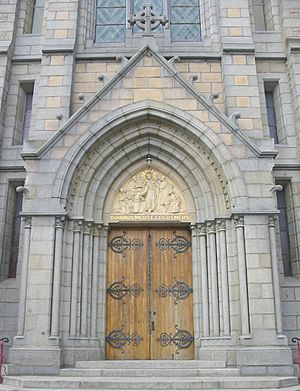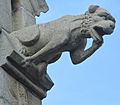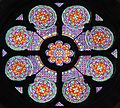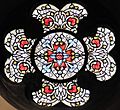St Thomas Church, Jersey facts for kids
Quick facts for kids St Thomas Church |
|
|---|---|
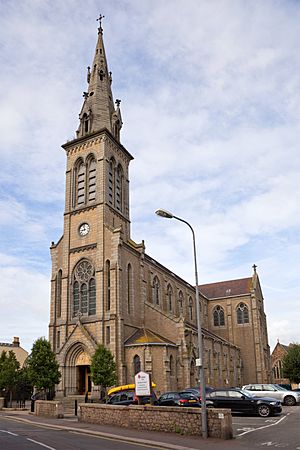 |
|
| 49°11′20″N 2°06′20″W / 49.1888°N 2.1056°W | |
| Location | Val Plaisant, St. Helier |
| Country | Jersey |
| Denomination | Roman Catholic |
| Website | catholicchurch.org.je |
| History | |
| Consecrated | 5 September 1893 |
| Architecture | |
| Architect(s) | Alfred Frangeul |
| Style | Gothic Revival |
| Years built | 1883–1887 |
| Specifications | |
| Spire height | 196 feet |
| Administration | |
| Diocese | Portsmouth |
| Province | Southwark |
St Thomas Church (Jèrriais: Églyise dé Saint Thonmas) is a large Roman Catholic church located in St. Helier, Jersey. It is the biggest church in the Channel Islands and first opened its doors in 1887.
Contents
History of St Thomas Church
Catholicism Returns to Jersey
During the French Revolution, many people fled France and came to Jersey. Among them were Catholic bishops, priests, and regular church members. They needed places to worship, so Catholic chapels were set up in St. Helier. This helped bring Catholicism back to Jersey.
Building a New Church
The first permanent Catholic church after the English Reformation was a Protestant chapel that was changed for Catholic worship in 1842. It was named after St. Thomas to honor Bishop Thomas Griffiths, who opened it.
In 1880, a group called the Oblates of Mary Immaculate took over the church. They soon started raising money to build a brand new church. This new church, located in Val Plaisant, opened in 1887. French-speaking church members were so proud of it that they called it La Cathédrale, meaning "The Cathedral."
The church was officially blessed and dedicated on September 5, 1893. This date was chosen to celebrate 100 years since the Catholic Church was re-established in the Channel Islands in 1793.
Important People in the Church's History
From 1880 to 1999, French priests from the Missionary Oblates of Mary Immaculate served the church. Father Donat Michaux, O.M.I., was very important. He raised the money and managed the building of the church, so he is seen as its founder.
In 1984, the church was updated for new worship practices. It was beautifully restored again in 2006 and 2007 under the guidance of Monsignor Nicholas France.
About the Church Building
St. Thomas's Church is built in a style popular in the 1200s, known as Gothic Revival. It has a main area called the nave, side sections called aisles, and parts that stick out like arms, called transepts, which have chapels. There's also a special area near the altar called the chancel.
Inside the Church: Frescos
The church has amazing fresco paintings. Near the large round window, there are paintings of angels playing music and singing. Above these, you can see paintings of many saints, including St. Thomas of Aquinas, St. Thomas the Apostle, St. Louis IX, King of France, and St. George, the patron saint of England. You'll also see St. Joan of Arc, St. Peter, the Blessed Virgin Mary, St. Joseph, and St. Anne.
Other paintings show symbols like the Good Shepherd and the Holy Redeemer.
The main part of the church, the nave, has seven large arches. The chancel is separated from the chapels by a big arch. The walls of the nave and chancel are supported by strong pillars made of Crazannes stone. Each pillar has a unique carved top with designs of leaves, flowers, and buds.
How Big is the Church?
The nave is 60 feet high inside. The side aisles are 30 feet high. The nave is 109 feet long from the front to the inner door. The chancel is 36 feet long. The church is 89 feet wide across the transepts. From the outside, the church is 179 feet long, and inside it's 163 feet long.
The Roof and Vaults
The church's arched roof, called a groined roof, is made of hollow bricks covered with plaster to look like stone. The vaults are decorated with carved designs.
The vaults are made stronger by supports called buttresses, both inside and outside. On top of the outside supports, you can see gargoyles, which are carved stone figures that look like mythical creatures.
The Steeple and Its Features
The church's tall tower, or steeple, is made of granite from Brittany. It has a main entrance, called a portal, with a carving above it. This carving shows Jesus appearing to St. Thomas the Apostle after His Resurrection. Above the portal is a large window with a rose design.
The steeple is very tall, reaching 111 feet from the ground to the spire windows. From there to the very top of the cross, it's another 85 feet, making the total height 196 feet!
Clock and Bells
High up in the tower is the belfry, where five bells are located. These bells have special names:
- Eloise-Ida-Therese de l’FJ
- Clotilde-Louise-Leonie
- Marie Immaculee
- Anne-Marie-Andree-Ignace
Two of the bells were made by Cornille-Havard, and the other three by Paccard of Annecy. Below the belfry is an electric clock that strikes the hours.
Organ and Gallery
The church has a large organ, installed in 1959 by Henry Willis & Sons. It has two keyboards and a pedal-board. The organ is located in a big gallery that extends over the entrance and into the main part of the church. This gallery is supported by three arches and decorated with carved panels.
Priests Who Served the Church
When the Catholic Church was re-established in Jersey in 1793, it was guided by two bishops from France. They were helped by priests like Rev. Mathieu de Gruchy, who performed religious services in private chapels.
Priests in Charge of French-Speaking Catholics (1803-1961)
- J. Philibert - 1803
- F. Le Guedois - 1809
- J. Morlais - 1837
- J. Volkerick - 1860
- M. Morin - 1878
- V. Bourde - 1880
- V. Fick - 1885
- C. Le Vacon, O.M.I. - 1895
- L. Legrand, O.M.I. - 1899
- L. Guillient, O.M.I. - 1911
- A. Mao, O.M.I. - 1920
- T. Mare, O.M.I. - 1933
- P. Jon, O.M.I. - 1946
- H. Verkin, O.M.I. - 1955
- J. Simon, O.M.I. - 1961
St Thomas Church Today
Today, St. Thomas's is part of the Roman Catholic Diocese of Portsmouth and is served by local priests.
The church is a welcoming place for people from many different countries and backgrounds. It is especially important to the large number of Portuguese and Polish people who have moved to Jersey for work. Mass is regularly held in Portuguese and Polish, and sometimes in French.
Next to the church, there is a presbytery (where priests live) and a church office, along with a church hall. On the other side, another building houses Catholic Pastoral Services, the Welcome Centre, and the office of the Society of St. Vincent de Paul.
Gallery
-
St. Thomas and his message in different languages
See also
 In Spanish: Iglesia de Santo Tomás (Jersey) para niños
In Spanish: Iglesia de Santo Tomás (Jersey) para niños
- Catholic Church in Jersey
- Our Lady of the Annunciation Church, Jersey
- Religion in Jersey


